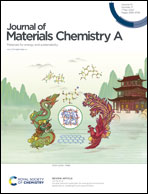Surface microstructural engineering of silicone elastomers for high performance adhesive surface-enabled mechanical energy harvesters†
Abstract
Triboelectric nanogenerators (TENGs) based on the coupled effects of contact electrification (CE) and electrostatic induction are increasingly emerging as an efficient, economical, easily accessible and scalable electric power generating technique by scavenging the low-frequency mechanical energy that broadly exists but is wasted in the environment. This work demonstrated that the unique and unconventional CE technique of using viscoelastic polymer adhesives (VPAs) for the assembly of a class of adhesive surface-enabled TENGs (AS-TENGs) is a general and more highly efficient strategy for largely enhanced mechanical energy harvesting performance, just by surface microstructural engineering of their CE pairing material (such as silicone elastomers) for suitably lowering the interfacial adhesion. AS-TENGs possessed an unusual AC signal with electric peaks generated during the separating process obviously larger than those triggered during the contacting process, showing both unique force- and frequency-insensitive output characteristics. They generally output 1.79–6.17 times the average peak voltage achieved by conventional TENGs based on triboelectric materials with non-adhesive surfaces under the same triggering conditions (200–400 N and 1.1–3.3 Hz), equivalently generating 110–2215% more electric energy. One main reason for the outstanding performance of AS-TENGs was ascribed to the high triboelectric charge density of VPAs, while another main reason was owing to their intrinsic adhesion and viscoelasticity. They can lead to an instantaneous separation between VPA and SE surfaces like the sudden tensile failure of a rubber band, as a result of driving induced charges across a load in a less time for higher output current/voltage, which was verified by a newly proposed peak-to-peak time interval analysis. AS-TENGs are believed to have unique applications in either scavenging or detecting small mechanical energy generated in our daily work and life. As a proof of demonstration, they were finally developed as a class of flexible and freestanding mechanical energy harvesting and sensing units with a tailorable size and shape to be mounted on a keyboard for both scavenging typewriting mechanical energy and monitoring typewriting habits successfully.



 Please wait while we load your content...
Please wait while we load your content...